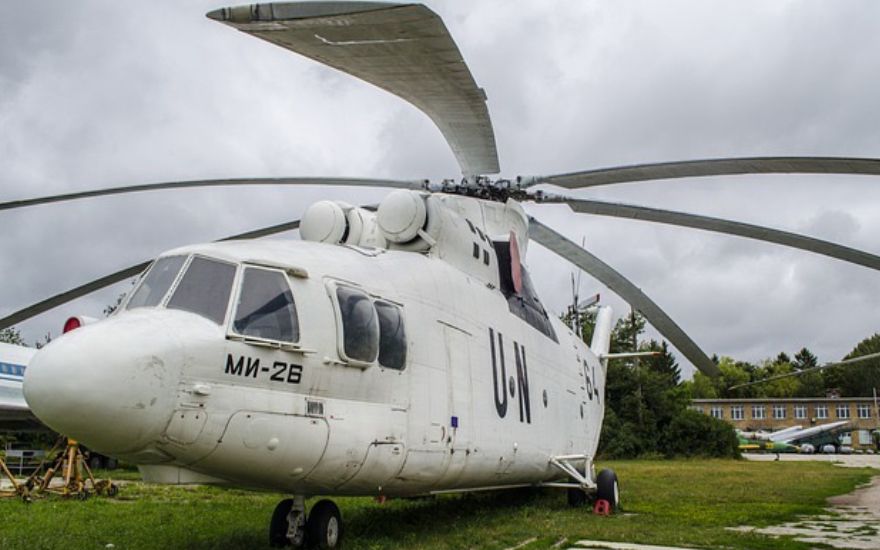
The Mil Mi-26, a Soviet-era engineering marvel, also known as the Halo, remains the world’s most potent and heaviest-lifting helicopter. Decades after its launch, the helicopter remains unmatched in its ability to carry up to 20-tonnes of cargo, far surpassing any other rotary-wing aircraft. This jaw-dropping capability has made the Mi-26 indispensable in military, disaster relief, and heavy-lift operations worldwide.
One of the stand-out features is its eight-blade main rotor, a design that significantly enhances its lift capability. Unlike most heavy-lift helicopters, which often feature six blades, such as the Sikorsky CH-53K King Stallion, the Mi-26’s additional blades provide greater surface area and lift generation. The rotor system spans an impressive 32m in diameter, making it one of the largest-ever built for a helicopter.
This design allows the Mi-26 to sustain heavy loads while maintaining stability, a critical factor when operating in challenging environments such as high altitudes or adverse weather conditions. The rotor blades are also equipped with advanced materials and aerodynamic features to minimise drag and maximise efficiency. This combination of size, design, and engineering ensures that the Mi-26 can handle payloads that would be impossible for other helicopters.
Dual D-136 turboshaft enginesAt the heart of the Mi-26’s performance are its two Lotarev D-136 turboshaft engines, each generating a huge 11,400 shaft horsepower (shp). These engines produce a combined output of 22,800shp, nearly double the power of most Western heavy-lift helicopters. For comparison, the Sikorsky CH-53K King Stallion, one of the
most powerful Western helicopters, is powered by three General Electric T408 engines producing 22,500shp. Furthermore, the Boeing CH-47F Chinook relies on two Honeywell T55 engines generating 9,600shp.
The Mi-26’s raw power allows it to perform under extreme conditions, whether lifting military vehicles, construction equipment, or even another downed helicopter. The engines are also designed to operate efficiently in high-altitude environments, making the Mi-26 a reliable choice for missions in mountainous regions or remote areas with limited infrastructure.
The helicopter also features an advanced split-torque transmission system that can handle its juge power output without excessive wear or heat build-up. Most helicopters face limitations due to the stress placed on transmission components, but the Mi-26’s gearbox efficiently distributes power to the main rotor while reducing mechanical strain.

This transmission system is a key factor in the Mi-26’s ability to lift heavy loads consistently and safely. By contrast, even the CH-53K, with its high-tech drivetrain, cannot match the Mi-26’s lifting capacity despite similar power levels.
Furthermore, the Mi-26 can be compared to fixed-wing cargo aircraft due to the enormous size of its cargo bay, which can accommodate vehicles, supplies, or personnel. The internal dimensions of the cargo bay are 12m long, 3.2mwide, and 3m high, making it possible to fit bulky loads that would otherwise require a C-130 Hercules transport plane. The Lockheed C-130 Hercules has a maximum payload of 19 tonnes, while the Boeing C-17 Globemaster III can carry up to 77.5 tonnes. However, unlike fixed-wing transporters, the Mi-26 can take off and land virtually anywhere, making it ideal for remote operations.
High-strength materialsThe fuselage is constructed from high-strength materials, including titanium and advanced composites, to withstand the stresses of heavy lifting. The cargo bay is equipped with a reinforced floor and a loading ramp, allowing for the easy transport of over-sized items such as military vehicles, construction machinery, and even other helicopters.

While many nations have Mi-26 helicopters for emergency relief and military operations, it is possible to organise a
helicopter charter for private aviation.
The Mi-26 is frequently used to transport heavy military equipment, including tanks, howitzers, and troops. Its ability to operate in remote or inaccessible areas makes it useful for the military; disaster relief — in the aftermath of natural disasters, the Mi-26 has been deployed to deliver humanitarian aid, evacuate civilians, and transport emergency supplies.
The helicopter’s ability to access areas without runways or infrastructure is particularly valuable in disaster zones. Its price,
coming in at around £20 million, makes it more cost-effective than most other heavy-lift military aircraft to use for civilian missions; aerospace recovery — the Mi-26 has been used to recover space capsules and rocket components, showcasing its ability to handle delicate and high-value cargo; heavy equipment transport — helicopters are often employed to move drilling rigs, construction materials, and even other helicopters. In one notable instance, the Mi-26
was used to transport a damaged CH-47 Chinook in a remote location.
The Mi-26 will always be a technological marvel that is in a league of its own. Its combination of heavy duty features enable it to perform tasks that no other existing helicopter can. Even decades after its introduction, it continues to set the standard for heavy-lift helicopters, demonstrating one of the few examples of enduring Soviet-era engineering.